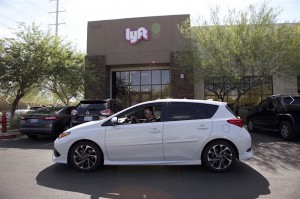
Drivers for ride-hailing services are being reclassified in some places moving from contractors to employees.
The nation’s two largest ride-hailing services, Uber and Lyft, were already hammered by the coronavirus pandemic when they got word that they now will have to treat their drivers as employees, rather than contractors.
How to view those who actually work on the front line for app-based services, especially ride-hailing companies, has become a major issue in what many refer to as the “gig economy.” California has, more broadly, begun taking a hard line on freelancers and contractors in a variety of different areas including journalists as well as drivers for transportation network companies, or TNCs.
“For now, TNC drivers are presumed to be employees and the Commission must ensure that TNCs comply with those requirements that are applicable to the employees of an entity subject to the Commission’s jurisdiction,” California Public Utilities Commissioner Genevieve Shiroma said in a statement following her ruling on AB5, a new law that went into effect on Jan. 1.
(Uber, Lyft post Q1 losses; find bright spots in business.)
That measure sets a much higher bar for companies that have been classifying workers as contractors rather than employees, an approach that has become increasingly commonplace everywhere from newspapers to assembly lines, and especially among high-tech companies.
California’s approach is more than a matter of semantics. It could impact the companies in a variety of ways, including pay, time off, benefits, costs associated with the vehicles drivers use and more. But drivers could also face changes too, including what they can write off on taxes and in what way.
But the announcement is expected to be extremely popular with Uber and Lyft contractors, many of whom have been pushing to have themselves reclassified as employees. Both in the U.S. and abroad, there have been a number of actions, including strikes, during the last several years for better pay and working conditions, as well as support demands to be relabeled employees.
Exactly how many drivers will be impacted is far from clear. Both companies have been extremely vague about such details and, with drivers generally allowed to pick their own work slots, the number can vary widely from week-to-week and even day-to-day. Analysts have generally estimated that Uber has at least 2 million drivers worldwide, Lyft slightly less.
During a livestream presentation to drivers last February, Uber CEO Dara Khosrowshahi offers the most solid hint yet when he said, “Millions of people around the world drive with Uber every single week.”

Uber CEO Dara Khosrowshahi said that “millions of people” use Uber daily, giving some insight into how many drivers the company has.
For now, the decision by the California PUC will impact only those drivers operating within the state, though there have been moves to reclassify those elsewhere and the news could inspire activist drivers in other locations.
(Lyft surpasses autonomous rides milestone.)
While Uber has not yet responded to Commissioner Shiroma’s decision, Lyft said in a statement, “CPUC’s presumption is flawed. Forcing them (drivers) to be employees will have horrible economic consequences for California at the worst possible time.”
The news quickly hammered the stock prices for both companies. At 2 p.m. Thursday Uber shares were trading at $31.73, down 8.91% from Wednesday’s close. Lyft traded at $35.99, down 6.66% from the prior close.
Uber, the bigger of the two, is off sharply from its 52-week high of $47.08, though still trading at more than double its 52-week low of $13.71.
But investors have become more wary in recent months, according to industry analysts, and the contractor/employee question is just one reason. Perhaps the bigger question is how ride-hailing companies will fare, longer-term as the world emerges from the coronavirus pandemic. Use of both ride-hailing and public transportation has falling off dramatically since pandemic lockdowns first began, and there are signs that neither will recover quickly.
Studies by Capgemini, IBM and LMC Automotive have all found sizable shares of the public saying they won’t ride in a ride-hailing vehicle or on a bus or subway in the future for fear of catching COVID-19, the disease caused by the coronavirus.
Asked to respond to the statement, “I will prefer to use fewer ride-hailing services (in the future) owing to health and safety concerns,” 43% of those surveyed by Capgemini, a transportation research and consulting firm, agreed, only 35% disagreeing.
(Uber, Lyft drives have poor recall repair record.)
If that holds as more places come out of lockdown it could worsen the already significant losses the two major ride-hailing services have been running up. Uber alone went $2.9 billion into the red during the first quarter of the year.


